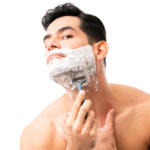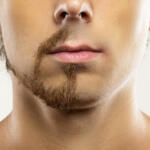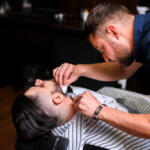
Are you feeling discomfort from a large, hard bump on your skin? Has this bump become red and tender, causing you to suspect it’s an ingrown hair cyst? Fear not! This comprehensive guide covers everything you need to understand about this common skin condition. Here, we’ll demystify the causes, symptoms, diagnostic procedures, and potential treatments for ingrown hair cysts. We’ll also bust common myths to equip you with the right knowledge to manage and prevent ingrown hair cysts.
Table Of Contents
−- Understanding Ingrown Hair Cysts
- The Nature of Ingrown Hair Cysts
- The Size of an Ingrown Hair Cyst
- Recognizing an Ingrown Hair Cyst
- When to Consult a Doctor
- Diagnosing an Ingrown Hair Cyst
- Treatment Options for Ingrown Hair Cysts
- Home Treatments for Ingrown Hair Cysts
- Preventing Ingrown Hair Cysts
- Myths and Misconceptions Surrounding Ingrown Hair Cysts
- Wrapping Up: Managing Ingrown Hair Cysts
Understanding Ingrown Hair Cysts
Ingrown hair cysts, a widespread skin condition, result from hair growing inwards rather than breaking through the skin’s surface. They can cause both physical discomfort and psychological distress due to their appearance. The good news is, with proper care, most of these cysts clear up within one to two weeks. More severe cases, however, might require professional treatment.
The Nature of Ingrown Hair Cysts
These cysts appear when an ingrown hair gets trapped beneath the skin, causing pain and, often, visible lumps. Symptoms range from redness, swelling, and tenderness, to a detectable bump under your skin. If the cyst doesn’t resolve independently, you may need to seek medical help, which could involve removal procedures. To prevent this from happening, practice good skin care, like using clean razors and refraining from wearing tight clothing that may irritate your skin.
The Size of an Ingrown Hair Cyst
Ingrown hair cysts can vary in size, starting as small red pimples and potentially expanding up to an inch in diameter. They can sometimes lead to infected pustules, appearing as round lumps with white or yellow centers and a small black plug at the top. Such untreated cysts can cause further discomforts, like irritation and itching, making it crucial to address them early.
Recognizing an Ingrown Hair Cyst
Knowing the signs and symptoms of an ingrown hair cyst can aid early detection. Typical signs include a raised bump, redness, and swelling around the bump, accompanied by pain or discomfort. In some cases, these cysts can get infected and fill with pus, leading to pain, itching, and possible abscess formation around the cyst. If you notice any of these symptoms, it’s advisable to seek medical attention for appropriate treatment.
When to Consult a Doctor
Although many ingrown hair cysts heal independently within a week or two, some cases might require medical attention. Seek professional help if the cyst appears large and painful, shows signs of infection, or doesn’t improve after one to two weeks. A dermatologist can accurately diagnose the condition and recommend suitable treatments to minimize the cyst’s size and inflammation.
Diagnosing an Ingrown Hair Cyst
A proper diagnosis of an ingrown hair cyst ensures correct treatment. If home treatments don’t seem to improve the cyst after a week, consider visiting a doctor. Medical professionals can examine the cyst, perform necessary tests, and prescribe medications or topical creams to aid recovery. With the correct diagnosis and treatment, most ingrown hair cysts should disappear within a few weeks.
Treatment Options for Ingrown Hair Cysts
Ingrown hair cysts can be treated in various ways, from home treatments to professional medical procedures. Home treatments, such as warm compresses or over-the-counter anti-inflammatory drugs like ibuprofen, can help reduce inflammation and pain.
If the cyst is notably large or painful, a doctor might recommend a corticosteroid injection. Other treatments could include draining the cyst or removing it through laser or surgical intervention. If you’re susceptible to ingrown hairs and cysts, your doctor may suggest preventative measures like using mild soaps and avoiding skin-irritating activities.
Home Treatments for Ingrown Hair Cysts
Applying warm compresses to the cyst for 10-15 minutes several times a day can expedite the healing process by bringing the cyst closer to the surface, facilitating its drainage. Keeping the affected area clean and avoiding shaving or tweezing around it can prevent infections and aid healing. Many over-the-counter creams and ointments can also treat ingrown hair cysts effectively. However, if your condition doesn’t improve after trying these home remedies, it’s critical to seek medical help.
Preventing Ingrown Hair Cysts
Preventing ingrown hair cysts involves maintaining proper hygiene. Avoid shaving too closely or using dull blades. Regular exfoliation with a gentle scrub or loofah can remove dead skin cells and other debris that could trap ingrown hairs. It’s also advisable to steer clear of waxing or tweezing, as these methods can irritate the skin and increase the risk of ingrown hairs. Moisturizing the area post-shaving or exfoliating keeps your skin hydrated and less prone to develop an ingrown hair cyst.
Myths and Misconceptions Surrounding Ingrown Hair Cysts
It’s crucial to debunk common misconceptions about ingrown hair cysts for effective self-treatment. For instance, popping an ingrown hair cyst might seem like a quick solution, but it can lead to infection. Contrary to popular belief, shaving can indeed cause ingrown hairs. Therefore, practicing safe shaving techniques is necessary. Lastly, while some ingrown hair cysts may heal independently without any intervention, timely treatment can help avoid complications.
Wrapping Up: Managing Ingrown Hair Cysts
While ingrown hair cysts can take several days or weeks to fully clear up, adopting proper treatment strategies can alleviate symptoms and hasten to heal. Prevention plays a vital role in avoiding the recurrence of ingrown hair cysts. By exfoliating before shaving and using sharp razor blades, you can significantly minimize the risk of cyst formation. Take good care of your skin and prevent ingrown hair cysts from hampering your confidence and comfort.
Last update on 2024-05-01 / Affiliate links / Images from Amazon Product Advertising API
Affiliate Disclosure: This post contains affiliate links, which means I may receive a small commission, at no extra cost to you, if you make a purchase using these links.

Jay Kang
Just because i'm asian does not mean I don't need shaving. I always wanted to grow a beard when I was young, now I need to shave because hair growth for me is a problem. I'm going through what every man will and has gone through before.





